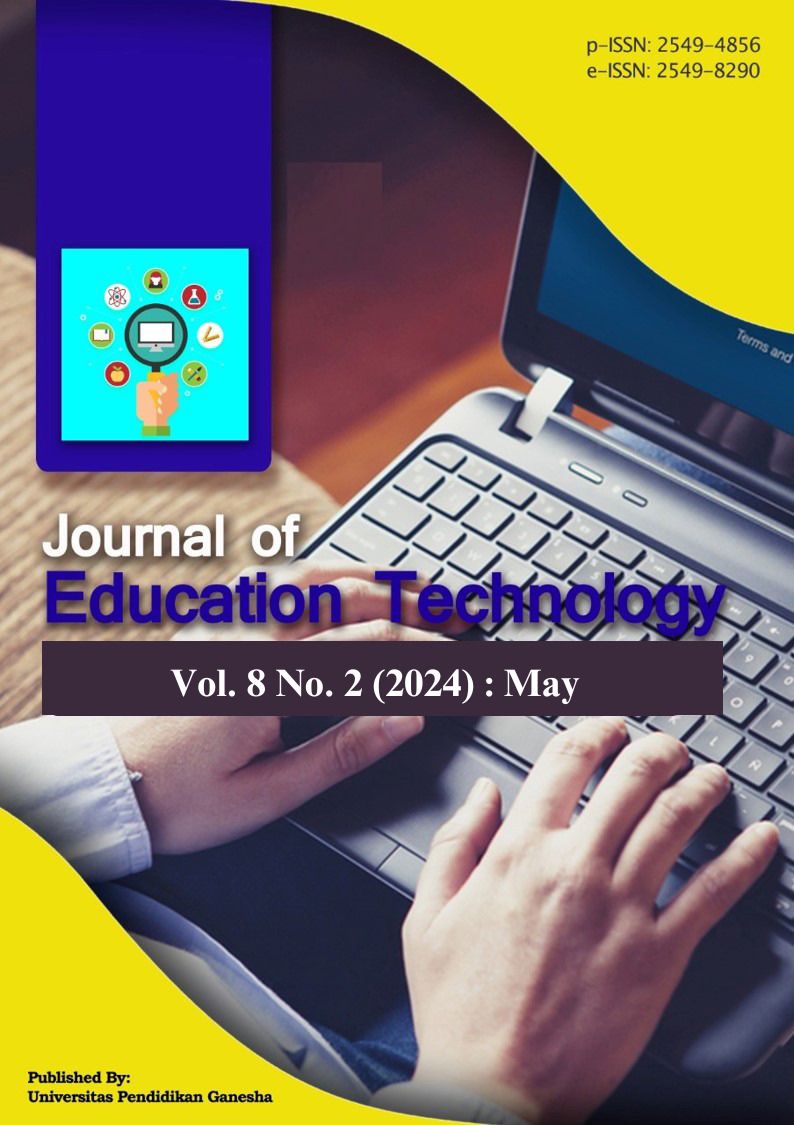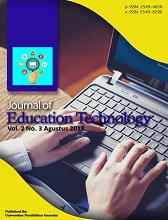Acceptance and Use of Digital Technology by Students in India After the Covid-19 Pandemic
DOI:
https://doi.org/10.23887/jet.v8i2.61944Keywords:
digital technology, behavioural intention, learning styles, mobile internet, hybrid learnersAbstract
After COVID 19 it was pertinent to ascertain acceptability and usage of digital technology by learners in India. Not all learners had similar behavioural intention of using digital technology. Taking it into consideration the study aimed to analyze learning styles of learners and trace its functional linkages to continuance usage of digital technology. Learners (n 242) who had skills of using mobile internet technology participated in the study. It was an empirical study based on qualtrics survey design. An attempt was made to substantiate model of structural linkages of constructs by Smart PLS-SEM technique. The study noted a set of findings: learners irrespective of their learning styles showed a willingness to continue usage of digital technology for open learning resources; paced learners had a direct linkage to use behaviour meaning that they were more organized and faster while using of digital tools for optimization of results; and hybrid-motivated learners had a strong behavioural intention for e-learning. Digital infrastructure in schools, if mismatched learning styles might result in a problem of use behaviour. Learners could be encouraged to participate in digital learning programme for maximization of gains. High acceptance and less use of digital technology required to be attended to address the gap between behavioural intention and use behaviour. The findings focused on learning styles that would help bridge a gap between acceptance and use of digital technology for school learning programme.
References
Balakrishanan, P. V, & Lay, G. C. (2016). Students’ learning styles and their effects on use of social media technology for learning. Telematics and Informatics, 33(3), 808–821. https://www.sciencedirect.com/science/article/abs/pii/S0736585315301155?via%3Dihub.
Bosica, J., Pyper, J. S., & MacGregor, S. (2021). Incorporating problem-based learning in a secondary school mathematics preservice teacher education course. Teaching and Teacher Education, 102, 103335. https://doi.org/10.1016/j.tate.2021.103335.
Buckley, P., & Doyle, E. (2016). Gamification and student motivation. Interactive Learning Environments, 24(6), 1162–1175. https://doi.org/10.1080/10494820.2014.964263.
Chou, S., Chen, C. W., & Lin, J. Y. (2015). Female online shoppers: Examining the mediating roles of e-satisfaction and e-trust on e-loyalty development. Internet Research, 25(4), 542–561. https://doi.org/https://www.researchgate.net/publication/280222066.
Dwivedi, Y. K., Rana, N. P., Chen, H., & Williams, M. D. (2017). A meta-analysis of the unified theory of acceptance and use of technology. In M. Nüttgensetal (Ed.), Governance and sustainability in IS (pp. 155–170). https://doi.org/https://link.springer.com/chapter/10.1007%2F978-3-642-24148-2_10.
Dwivedi, Y. K., Rana, N. P., Jeyaraj, A., Clement, M., & Williams, M. D. (2017). Re-examining the unified theory of acceptance and use of technology: Towards a revised model. Information Systems Frontiers, 21, 719–734. https://doi.org/10.1007/s10796-017-9774-y.
Falck, O., Mang, C., & Woessmann, L. (2018). Virtually no effect? Different uses of classroom computers and their effect on student achievement. Oxford Bulletin of Economics and Statistics, 80(1), 1–38. https://doi.org/10.1111/obes.12192.
Fang, Y., Chiu, C., & Wang, E. T. G. (2011). Understanding customers’ satisfaction and repurchase intentions: An integration of IS success model, trust, and justice. Internet Research, 21(4), 479–503. https://doi.org/https://www.researchgate.net/publication/220147076.
Fianu, E., Blewett, C., Ampong, G. O. A., & Ofori, K. S. (2018). Factors affecting MOOC usage by students in selected Ghanaian universities. Education Sciences, 8(2). https://doi.org/10.3390/educsci8020070.
Han, M., Wu, J., Wang, Y., & Hong, M. (2018). A model and empirical study on the user’s continuance intention in online China brand communities based on customer-perceived benefits. Journal of Open, 4(4), 1–20. https://doi.org/10.3390/joitmc4040046.
Kin, T. M., Omar, A. K., Musa, K., & Ghouri, A. M. (2022). Leading teaching and learning in the era of education 4.0: The relationship between perceived teacher competencies and teacher attitudes towards change. Asian Journal of University Education, 18(1). https://files.eric.ed.gov/fulltext/EJ1336198.pdf.
Kumar, R. (2021). National digital education architecture: Introduction and ideas. GoI Publishing. https://www.education.gov.in/shikshakparv/docs/Rajnish_Kumar.
Kumar, V., & Nanda, P. (2019). Social media in higher education: A framework for continuous engagement. International Journal of Information and Communication Technology Education (IJICTE), 1, 5(1), 97–108. https://doi.org/10.4018/IJICTE.2019010107.
Lai, P. C. (2017). The literature review of technology adoption models and theories for the novelty technologies. Journal of Information Systems and Technology Management, 14(1), 21–38. https://doi.org/https://papers.ssrn.com/sol3/papers.cfm?abstract_id=3005897.
Manikutty, S., Anuradha, N. S., & Hansen, K. (2007). Does culture influence learning styles in higher education? International Journal of Learning and Change, 2(1), 70–87. https://doi.org/10.1504/IJLC.2007.014896.
Mee Mee, R. W., Shahdan, T. S. T., Ismail, M. R., Abd Ghani, K., Pek, L. S., Von, W. Y., Woo, A., & Rao, Y. S. (2020). Role of gamification in classroom teaching: Pre-service teachers’ view. International Journal of Evaluation and Research in Education, 9(3), 684–690. https://doi.org/10.11591/ijere.v9i3.20622.
Mouakket, S. (2020). Investigating the role of mobile payment quality characteristics in the United Arab Emirates: Implications for emerging economies. International Journal of Bank Marketing, 38(7), 1465–1490. https://www.emerald.com/insight/content/doi/10.1108/IJBM-03-2020-0139/full/html.
Moussa, N. (2018). Learning styles and the adoption of modern technology among adult learners. Institute of Learning Style Journal, 1, 11–21. http://www.auburn.edu/academic/education/ilsrj/Journal Volumes/Spring 2018 Vol 1 PDFs/LearningStyles Moussa.pdf.
Olushola, T., & Abiola, J. O. (2017). The efficacy of technology acceptance model: A review of applicable theoretical models in information technology researches. Journal of Research in Business and Management, 4(11), 70–83. https://www.sciencedirect.com/science/article/pii/S0268401216300329.
Paidican, M. A., & Arredondo, P. A. (2022). The Technological-Pedagogical Knowledge for In-Service Teachers in Primary Education: A Systematic Literature Review. Contemporary Educational Technology, 14(3), 1–15. https://doi.org/10.30935/cedtech/11813.
Panisoara, I. ., Lazar, I., Panisoara, G., Chirca, R., & Ursu, A. S. (2020). Motivation and continuance intention towards online instruction among teachers during the COVID-19 pandemic: The mediating effect of burnout and techno-stress. International Journal of Environmental and Public Health Research, 17(2), 2–28. https://doi.org/https://pubmed.ncbi.nlm.nih.gov/33143180.
Papadakis, S., Vaiopoulou, J., Kalogiannakis, M., & Stamovlasis, D. (2020). Developing and Exploring an Evaluation Tool for Educational Apps (ETEA) Targeting Kindergarten Chil-dren. Sustainability, 12(10), 4201. https://doi.org/10.3390/su12104201.
Schukajlow, S., Blomberg, J., Rellensmann, J., & Leopold, C. (2022). The role of strategy-based motivation in mathematical problem solving: The case of learner-generated drawings. Learning and Instruction, 80(October 2021), 101561.1-9. https://doi.org/10.1016/j.learninstruc.2021.101561.
Sheromova, T. S., Khuziakhmetov, A. N., Kazinets, V. A., Sizova, Z. M., Buslaev, S. I., & Borodianskaia, E. A. (2020). Learning styles and development of cognitive skills in mathematics learning. Eurasia Journal of Mathematics, Science and Technology Education, 16(11). https://doi.org/10.29333/EJMSTE/8538.
Singh, C. B. P. (2017). Multilevel exclusion of dalit students in professional elite colleges of India. Social Change, 47(3), 363–371. https://doi.org/https://www.researchgate.net/publication/319110446_.
Singh, C. B. P. (2022). COVID 19 and continuance intention to use tech-based pedagogy: A moderating- mediation model of teachers’ satisfaction. Journal of Educational Planning and Administration, 36(2), 117–134. http://www.niepa.ac.in/download/Publications/JEPA/2023/JEPA January 2022_watermark.pdf.
Sprenger, A., & Schwaninger, A. (2021). Technology acceptance of four learning technologies (response system, classroom chat, e-lectures and mobile virtual reality) after three months usage. International Journal Educational Technology in Higher Education, 18(8), 1–17. https://doi.org/10.1186/s41239-021-00243-4.
Venkatesh, V., Thong, J. Y. L., & Xu, X. (2012). Consumer acceptance and use of information technology: Extending the unified theory of use and acceptance of technology. MIS Quarterly, 36(1), 157–178. https://doi.org/10.2307/41410412.
Venkatesh, V., Thong, J. Y. L., & Xu, X. (2016). Unified theory of acceptance and use of technology: A synthesis and the road ahead. Journal of Association for Information Systems, 17(5), 328–376. https://papers.ssrn.com/sol3/papers.cfm?abstract_id=2800121.
Von Kotzebue, L. (2022). Two is better than one—examining biology-specific TPACK and its T-dimensions from two angles. Journal of Research on Technology in Education, 1-18. https://doi.org/10.1080/15391523.2022.2030268.
Wang, J., Li, X., Wang, P., Liu, Q., Deng, Z., & Wang, J. (2022). Research trend of the unified theory of acceptance and use of technology: A bibliometric analysis. Sustainability, 14(10), 1–20. https://www.researchgate.net/publication/357223799.
Wei, Y., Shi, Y., MacLeod, J., & Yang, H. H. (2022). Exploring the Factors That Influence College Students’ Academic Self-Efficacy in Blended Learning: A Study From the Personal, Interpersonal, and Environmental Perspectives. SAGE Open, 12(2), 1–12. https://doi.org/10.1177/21582440221104815.
Zhang, X., Wang, W., Pablos, P. O., Tang, J., & Yan, X. (2015). Mapping development of social media research through different disciplines: Collaborative learning in management and computer science. Computers in Human Behaviour, 51, 1142–1153. https://doi.org/10.1016/j.chb.2015.02.034.
Downloads
Published
How to Cite
Issue
Section
License
Copyright (c) 2024 Chandra B P Singh

This work is licensed under a Creative Commons Attribution-ShareAlike 4.0 International License.
Authors who publish with the Journal of Education Technology agree to the following terms:
- Authors retain copyright and grant the journal the right of first publication with the work simultaneously licensed under a Creative Commons Attribution License (CC BY-SA 4.0) that allows others to share the work with an acknowledgment of the work's authorship and initial publication in this journal.
- Authors are able to enter into separate, additional contractual arrangements for the non-exclusive distribution of the journal's published version of the work (e.g., post it to an institutional repository or publish it in a book), with an acknowledgment of its initial publication in this journal.
- Authors are permitted and encouraged to post their work online (e.g., in institutional repositories or on their website) prior to and during the submission process, as it can lead to productive exchanges, as well as earlier and greater citation of published work. (See The Effect of Open Access)


















